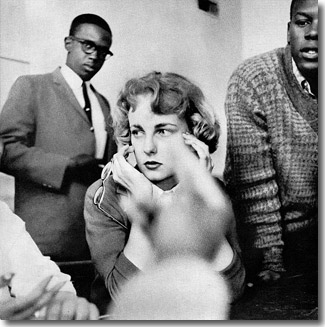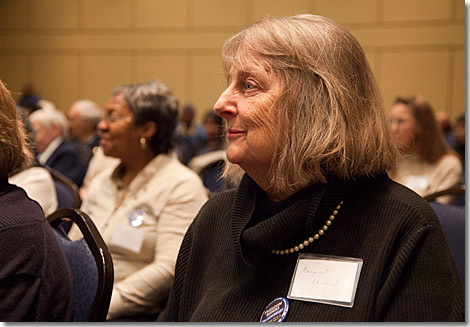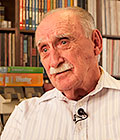Margaret Leonard "Introduction to a Sit-In"
 "Before the sit-in, Sissy [Margaret Leonard] gets her instructions. She will first order food at the white counter, then give it to Negroes." Photo by V. Thoma Kersh. |

Margaret Leonard at a reunion for Freedom Riders in Chicago supported by Oprah Winfrey. She is retired now after a long career as a journalist across the South, and she's still passionate about progressive politics. Photo by Bill Ganzel, May 2011. |
|
Civil Rights is a rich story line for the Sixties Survivors project because the decade saw historic changes that were pushed by people like Margaret Leonard. "Sissy" – as she was known in her family – wanted the rest of America to know that not everyone in the South "was evil," she says. "Not that we called the segregationists evil to their faces," she says. Leonard came to her commitment naturally. Her mother was Margaret Long, a progressive columnist for the Atlanta Journal, who wrote an article in "The Second Battle of Atlanta" edition of LOOK that also featured Lonnie C. King. Her cousin was George B. Leonard, a senior editor for LOOK who covered race extensively throughout the 60s. Sissy's own LOOK story began when she was a student at Sophie Newcomb College in New Orleans. She started going to CORE (Congress of Racial Equality) meetings and participated in both local sit-ins and the Freedom Rides of 1961. LOOK followed her through her training sessions for the sit-ins. "At the CORE meetings," she remembers, "they said, 'If somebody comes to hit you, protect your head.' But then in the Freedom Rides, they got real serious. We would go and spend some hours in a church basement being told what to do when they try to kill you. But to keep us from all getting scared and going home, they had some of that wonderful singing. We'd do some role-playing pretending like somebody was trying to kill us, and then we'd sing some of these great songs and get our courage back." Leonard says her favorite was "Freedom's Coming." |
According to Raymond Arsenault in his book Freedom Riders, Margaret Leonard was, "Blonde, blue-eyed, and fair-skinned. Leonard presented Mississippi officials with a disturbing development in the evolution of the Freedom Rides… She was the first unmistakably Southern white student to participate in the Mississippi Freedom Rides. [They were] fearful that other white Southern dissidents would follow her lead." Others did, and LOOK documented their stories in detail, with passion. Leonard is retired now from a reporting career at the St. Petersburg Times, Miami Herald, and Tallahassee Democrat. She occasionally reunites with other Freedom Riders. (And we intend to follow her to the next reunion in the Spring of 2010.) But she still remembers details of the second time she was arrested. "They decided to scare the shit out of me, and they did," she admits. "All they did was put me in a cell way back in the dark prison. They put me in the cell and locked the door and it clanked and they walked away and I was alone in the dark in a cell. I don't why that scared me, but it scared me a lot." Others, of course, went through worse.
One Freedom Rider, Thomas Armstrong III, has suggested the beatings and jailings may have resulted in PTSD symptoms. "I've always felt that many people who participated in the movement became wounded… and they received no help." |






